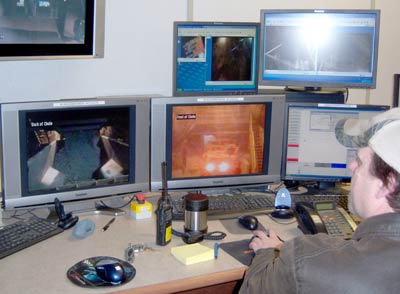 Nothing ever distracts the drivers of the two 40-tonne Toro haul trucks that go back and forth day in, day out between the Number 7 Chute and the Number 5 Crusher on the 9175 level at Barrick Gold’s Williams Mine in the Hemlo gold camp. That’s because there are no drivers.
Nothing ever distracts the drivers of the two 40-tonne Toro haul trucks that go back and forth day in, day out between the Number 7 Chute and the Number 5 Crusher on the 9175 level at Barrick Gold’s Williams Mine in the Hemlo gold camp. That’s because there are no drivers.
The Sandvik AutoMine system, acquired by Williams Mine in May 2007, is safer and easier on maintenance than conventionally driven trucks and more productive than a conveyor system in terms of tonnes hauled, says mine superintendent Bill Gascon. And the trucks never hit the walls.
The two automated Toros carry 75 per cent of the mine’s muck a distance of 800 metres from chute to crusher along a cordoned off, 5.5-metre drift 4,000 feet underground. It’s the only Sandvik AutoMine deployment in North America.
Lasers on the trucks scan the wall profile and upload the data to an onboard computer, explained systems specialist Richard Dubé. “It’s like an invisible rail.”
A traffic management system allows the two trucks to operate simultaneously in the same drift by automatically directing one truck to pull off into a turnaround to let the other pass. If mine personnel or any other vehicles enter the automation zone, the trucks come to a stop.
An operator on surface is able to view video from the trucks and take control if necessary from a remote control chair. Personnel on surface also teleoperate the chute and a rockbreaker at the other end of the 800-metre drift.
The trucks operate autonomously most of the time, but the automation cycle pauses for operator intervention at two points in the process. When a truck pulls into the loading zone, the operator on surface engages the chute and moves the truck forward to get a full load, following which a click of a mouse sends the truck on its way. Another mouse click is required to tell the trucks to turn around and head back after dumping their load.
Automation keeps drivers out of harm’s way and results in less wear and tear on the equipment, said Gascon.
Safety
“Whenever you put an operator on a truck, there’s always a risk involved, whether it’s getting up and down off the truck, checking the truck or operating it.”
Automation frees drivers from exposure to dust and the risk of injury if a truck blows a tire and runs into the wall. There’s also less risk of collisions because the system is cordoned off and won’t operate if equipment or mine personnel enter the automation zone.
“The trucks operate at upward of 18 kilometres per hour, so we’re running at higher speeds than most of our other trucks underground,” said Gascon.
The Toros have steering wheels, seats and all of the necessary controls for manual operation if the system is down or if there is a communication problem with the WiFi network, but “that’s very seldom – less than five per cent of the time,” said Dubé.
Another advantage of the AutoMine system is that the trucks can continue to haul ore through blast windows.
“At the end of every shift, the mine blasts and everyone has to clear out from underground,” said Gascon. “If we had operators, we’d have to clear them out. This way, we’re able to haul right through.”
There are only a half dozen other AutoMine deployments around the world, said Dale Rakochy, Sandvik’s Sudbury-based product line manager for trucks, loaders and automation. The other sites are the Tampere Test Mine and Inmet’s Pyhasalmi Mine in Finland, Codelco’s El Teniente Mine in Chile, De Beers’ Finsch Mine in South Africa, Xstrata’s Mount Isa Mine in Australia and the Nurkazgan Mine in Kazakhstan.
Fear
The primary challenge in selling the mining industry on automation is fear, said Rakochy.
“It’s a little black box technology and people are reluctant to embrace it.” Miners are used to “grabbing the levers. That’s the way they’ve mined their entire life and it’s hard to get past that.”
However, that mindset is bound to change as a younger, computer-savvy generation replaces the oldtimers, predicts Rakochy.
Even then, “automation isn’t for everybody,” he cautions. “The only time automation can really be applied successfully is if you have a predictable, repetitive (process).”
Block cave operations are a good example because “you can have multiple loaders in your herringbone pattern and the computer telling the loaders what drawpoint to pull from. That’s consistency. Once you have a block cave operation running, it’s going to run for years and years and the drawpoints and dumpoints will always be where they are.”
AutoMine Lite
Rakochy is also optimistic about Sandvik’s new AutoMine Lite solution for loaders in stope mining applications.
Using AutoMine Lite, an operator in a comfortable module outside the production area can teleoperate the bucket loading with the help of video and audio from the loader and switch to automated operation for the tramming and dumping.
AutoMine Lite can keep operators away from the heat, dust and noise of the production area and free them from having to climb up and down the loader as they do when using line-of-sight or video-assisted radio remote control.
“AutoMine Lite is going to be a game changer,” said Rakochy. “It’s something I really believe is going to make a huge difference.”
www.barrick.com
www.sandvik.com


